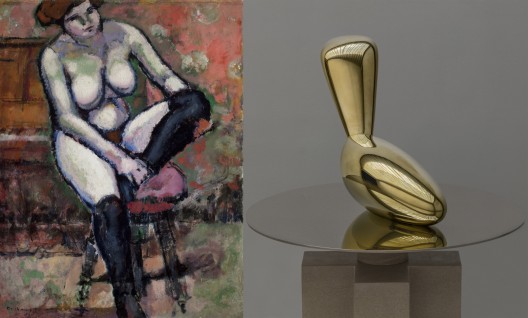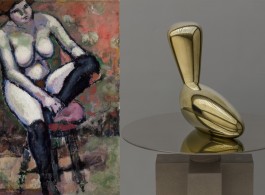Paul Kasmin Gallery
515 West 27th Street, New York

Marcel Duchamp, Nu aux bas noirs (Nude with Black Stockings), 1910, oil on canvas, 45 5/8 x 35 1/8 inches, 116 x 89 cm. © Artists Rights Society (ARS), New York/ADAGP, Paris/Estate of Marcel Duchamp. Vicky et Marcos Micha Collection, Mexico City. Photo by Francisco Cohen.
Constantin Brancusi, Leda, 1925, polished bronze, 21 1/4 x 27 1/2 x 9 1/2 inches, 54 x 70 x 24 cm, Edition of 5, cast by Susse Fondeur, Paris in 2016. © Succession Brancusi, all rights reserved/Artists Rights Society (ARS), New York/ADAGP, Paris.
Brancusi & Duchamp: The Art of Dialogue, curated by art historian Paul B. Franklin, explores the aesthetic dialogue between Constantin Brancusi (1876–1957) and Marcel Duchamp (1887–1968), two of the most inimitable and innovative artists of the twentieth century. Bringing together over eighty sculptures, objects, photographs, films, and drawings from an international array of public and private collections, as well as a selection of rare archival documents, this exhibition is the first of its kind in any American museum or gallery. Brancusi & Duchamp: The Art of Dialogue aims to enrich our knowledge of the personal and creative conversation that sustained these two utterly singular artists for years.
In addition to one original Brancusi sculpture and four posthumous casts in polished bronze, the exhibition features numerous vintage photographic prints by the sculptor of some of his most iconic creations, including Princess X, Leda, Endless Column, and Mademoiselle Pogany. Carefully composed in the confines of his Parisian studio, these images reveal a lesser-known and underappreciated aspect of Brancusi’s artistic process, in which he transformed his three-dimensional sculptures into entirely new artworks. Through the theatrical play of light and shadow, as well as the constantly evolving sculptural arrangements captured in these photographs, Brancusi conceived of his studio as space of experimentation and as an artwork in its own right. Also on view are several artworks by Brancusi that belonged to Duchamp’s wife, Alexina, who was his friend and an admirer.
While Duchamp commenced his artistic career as a painter, he quickly abandoned his brush in favor of more radical aesthetic endeavors inspired by a question that he had posed to himself in 1913: “Can one make works that are not ‘of art’?” His search for answers led him to conceive the readymades, mass-produced objects that he selected and isolated from their utilitarian context in order to undermine the artist’s touch and defy the concept of taste. Several of these celebrated and highly sculptural objects, such as In Advance of the Broken Arm (1915/1964), With Hidden Noise (1916/1964), and L.H.O.O.Q. (1919/1964), will be on display. Other Duchamp artworks featured in the exhibition include his early fauvist painting Nude with Black Stockings (1910), Rotoreliefs (Optical Disks) (1935), the Box in a Valise (1935–41), Female Fig Leaf (1950/1951), and his chess treatise Opposition and Sister Squares Are Reconciled (1932), the cover of which he designed in collaboration with Brancusi. Despite their remarkably different artistic trajectories and their seemingly divergent creative interests, Brancusi and Duchamp struck up a friendship in the 1910s that endured for decades. As well as installing and overseeing Brancusi’s first two major solo exhibitions in the United States in 1926–27 and in 1933–34, Duchamp also worked tirelessly alongside their mutual friend Henri-Pierre Roché on behalf of Brancusi, who lacked a dealer of his own, as his unofficial agents and intermediaries in the United States.
Brancusi and Duchamp broached a number of similar themes in their work including photography and film; eroticism and gender play; visual and verbal puns; kinetics and optics; the artist as custodian and curator of his oeuvre; the studio as a venue for experimentation; the objectness of things; and variations on a single subject or form. Through their wholly individual approaches to the creative process, Brancusi and Duchamp upended traditional notions of the artist, and in so doing they extended the limits of what was possible in the realm of art.
The exhibition will be accompanied by a fully illustrated catalogue written by Paul B. Franklin.
About Paul B. Franklin
Paul B. Franklin earned his doctorate in art history from Harvard University. Based in Paris, he is an independent scholar and an internationally recognized specialist on Marcel Duchamp. From 2000 to 2016, he served as editor in chief of the scholarly journal Étant donné Marcel Duchamp, one of the most highly acclaimed publications devoted to the artist and his work. He also has published and lectured widely on Duchamp.



